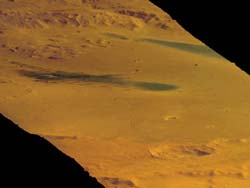International, interplanetary and no interference! Mars Express calls up Spirit

Spirit landed almost exactly in the middle of the area shown in this image taken by the HRSC <br>Credit: ESA
ESA PR 10-2004. A pioneering demonstration of communications between the European Space Agency’s Mars Express orbiter and NASA’s Mars exploration rover, Spirit, has succeeded.
On 6 February, while Mars Express was flying over the area that Spirit is examining, the orbiter transferred commands from Earth to the rover and relayed data from the rover back to Earth.
“This was the first in-orbit communication between ESA and NASA spacecraft, and we have also created the first working international communications network around another planet,” said Rudolf Schmidt, ESA’s Project Manager for Mars Express. “Both are significant achievements, two more ’firsts’ for Mars Express and the Mars exploration rovers.”
Jennifer Trosper, Spirit Mission Manager at NASA’s Jet Propulsion Laboratory, California, USA, said, “We have an international interplanetary communications network established at Mars.”
ESA and NASA planned this demonstration as part of continuing efforts to cooperate in space.
The commands for the rover were first transferred from Spirit’s operations team at JPL to ESA’s European Space Operations Centre in Darmstadt, Germany, where they were translated into commands for Mars Express. The translated commands were transmitted to Mars Express, which used them to command Spirit. Spirit used its ultra-high-frequency antenna to transmit telemetry information to Mars Express, and the orbiter then relayed the data back to JPL via the European Space Operations Centre.
“This is excellent news,” said JPL’s Richard Horttor, project manager for NASA’s roles in Mars Express. “The communication sessions between Mars Express and Spirit were pristine. Not a single bit of data was missing or added, and there were no duplications.”
This exercise demonstrates the increased flexibility and capabilities of inter-agency cooperation and highlights the close mutual support that is essential when undertaking international space exploration.
More information on the ESA Mars Express mission can be found at http://mars.esa.int
For further information, please contact:
ESA Media Relations Division
Franco Bonacina
Tel: +33(0)1.53.69.7155
Fax: +33(0)1.53.69.7690
Donald Savage
NASA Headquarters, Washington DC
Tel: 001 202 358 1547
Guy Webster
NASA Jet Propulsion Laboratory, Pasadena, Calif.
Tel: 001 818 354 5011
Media Contact
More Information:
http://www.esa.int/export/SPECIALS/Mars_Express/SEM2UE1PGQD_0.htmlAll latest news from the category: Communications Media
Engineering and research-driven innovations in the field of communications are addressed here, in addition to business developments in the field of media-wide communications.
innovations-report offers informative reports and articles related to interactive media, media management, digital television, E-business, online advertising and information and communications technologies.
Newest articles

Superradiant atoms could push the boundaries of how precisely time can be measured
Superradiant atoms can help us measure time more precisely than ever. In a new study, researchers from the University of Copenhagen present a new method for measuring the time interval,…

Ion thermoelectric conversion devices for near room temperature
The electrode sheet of the thermoelectric device consists of ionic hydrogel, which is sandwiched between the electrodes to form, and the Prussian blue on the electrode undergoes a redox reaction…

Zap Energy achieves 37-million-degree temperatures in a compact device
New publication reports record electron temperatures for a small-scale, sheared-flow-stabilized Z-pinch fusion device. In the nine decades since humans first produced fusion reactions, only a few fusion technologies have demonstrated…





















